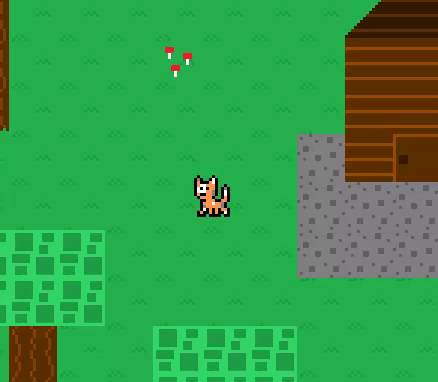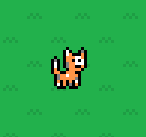Table of contents
Player States
The Player has several states it can be in based on the value of its playerState instance variable. Each state can lead to another state based on the player’s actions each cycle of the game loop. The states also dictate which animation/frames the player should switch to (e.g. player will switch to the walking animation when in the WALKING state) The PlayerState enum in the Level package define the following states that the player can be in:
- STANDING – player is standing still
- WALKING – player is walking
- INTERACTING – player is currently interacting with an entity
Player Standing State
If the player is on the ground and no keys are pressed, the player will enter its STANDING state, where it does nothing and just waits for another key to be pressed so it can be transitioned to a different state. The playerStanding method contains the simple logic for the STANDING state, which looks like this:
// player STANDING state logic
protected void playerStanding() {
if (!keyLocker.isKeyLocked(INTERACT_KEY) && Keyboard.isKeyDown(INTERACT_KEY)) {
keyLocker.lockKey(INTERACT_KEY);
map.entityInteract(this);
}
// if a walk key is pressed, player enters WALKING state
if (Keyboard.isKeyDown(MOVE_LEFT_KEY) || Keyboard.isKeyDown(MOVE_RIGHT_KEY) || Keyboard.isKeyDown(MOVE_UP_KEY) || Keyboard.isKeyDown(MOVE_DOWN_KEY)) {
playerState = PlayerState.WALKING;
}
}
It really just checks for arrow key presses to determine if the player should enter the WALKING state, and also checks if the interact key is pressed in order to tell the map that the player has attempted to interact with an entity.
While standing, the player uses either the STAND_RIGHT or STAND_LEFT animation.
Player Walking State

If the player is on the ground and either, right, left, up, or down arrow key is pressed, the player will enter its WALKING state, where it will move in a direction by a set number of pixels based on which key was pressed. If no keys are pressed while in this state, the player will stop moving and go back into its STANDING state. How fast the player walks is determined by the walkSpeed instance variable. The playerWalking method contains the logic for the WALKING state. The player will change the direction it’s facing if the left or right arrow key is pressed.
While walking, the player uses either the WALK_RIGHT or WALK_LEFT animation.
Player Interacting State
If the player is in STANDING or WALKING state and hits the interact key (space), it will reach out to a method in the map class’s entityInteract method to check if the player has successfully interacted with an entity that has an interact script. If the player successfully interacted with an entity, the entity’s interact script will be executed. Often times, the entity’s interact script will want the player to be “frozen” in place while the script is executing, so that the player can’t just walk away before the event has completed. The INTERACTING state is for this purpose – there is no logic in the playerInteracting method, meaning the player will be unable to do anything – can’t move, can’t interact with other entities, etc.
It is a script’s job to lock the player by setting its player state to INTERACTING. It is also a script’s job to unlock the player when it is ready (typically after the script has completed) by setting the player’s state back to something else (like STANDING). The Script class’s methods lockPlayer and unlockPlayer will handle doing this locking and unlocking of the player. Read more about scripts here.
